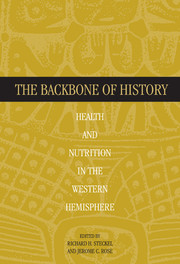Book contents
- Frontmatter
- Contents
- Preface
- List of Contributors
- PART I
- PART II METHODOLOGY
- PART III EURO-AMERICANS AND AFRICAN-AMERICANS IN NORTH AMERICA
- PART IV NATIVE AMERICANS IN CENTRAL AMERICA
- PART V NATIVE AMERICANS AND EURO-AMERICANS IN SOUTH AMERICA
- PART VI NATIVE AMERICANS IN NORTH AMERICA
- PART VII
- 19 Patterns of Health in the Western Hemisphere
- PART VIII
- PART IX EPILOGUE
- Index
19 - Patterns of Health in the Western Hemisphere
Published online by Cambridge University Press: 01 March 2010
- Frontmatter
- Contents
- Preface
- List of Contributors
- PART I
- PART II METHODOLOGY
- PART III EURO-AMERICANS AND AFRICAN-AMERICANS IN NORTH AMERICA
- PART IV NATIVE AMERICANS IN CENTRAL AMERICA
- PART V NATIVE AMERICANS AND EURO-AMERICANS IN SOUTH AMERICA
- PART VI NATIVE AMERICANS IN NORTH AMERICA
- PART VII
- 19 Patterns of Health in the Western Hemisphere
- PART VIII
- PART IX EPILOGUE
- Index
Summary
ABSTRACT
This chapter discusses time trends and related patterns in the health index that emerge across sites arranged by categories, such as climate, settlement size, and topography. A substantial decline in the index occurred in the millennia before the arrival of Columbus. The good health of the least complex societies did not occur because the Western Hemisphere was a biological Garden of Eden, an epidemiological paradise substantially free of pathogens so detrimental to health in other parts of the world: pre–Columbian populations were among the healthiest and the least healthy in our sample. While pre–Columbian natives may have lived in a disease environment substantially different from that in other parts of the globe, the original inhabitants also brought with them, or evolved with, enough pathogens to create chronic conditions of ill health under conditions of systematic agriculture and urban living. Our research suggests that life became “nasty, brutish and short” for the typical person with the rise of agriculture, government, and urbanization. The transition may have been driven by several factors, including resource depletion, efforts by leaders to redistribute wealth and power, and a voluntary desire to live with material goods and lifestyle provided by urban areas.
This project reveals a rich and varied history of health in the Western Hemisphere, as indicated by substantial variation in the health index of those who lived during the past several millennia. Although none of these populations were healthy by standards of the middle or late twentieth century, they were widely arrayed on the health index and its components.
- Type
- Chapter
- Information
- The Backbone of HistoryHealth and Nutrition in the Western Hemisphere, pp. 563 - 580Publisher: Cambridge University PressPrint publication year: 2002
- 23
- Cited by



